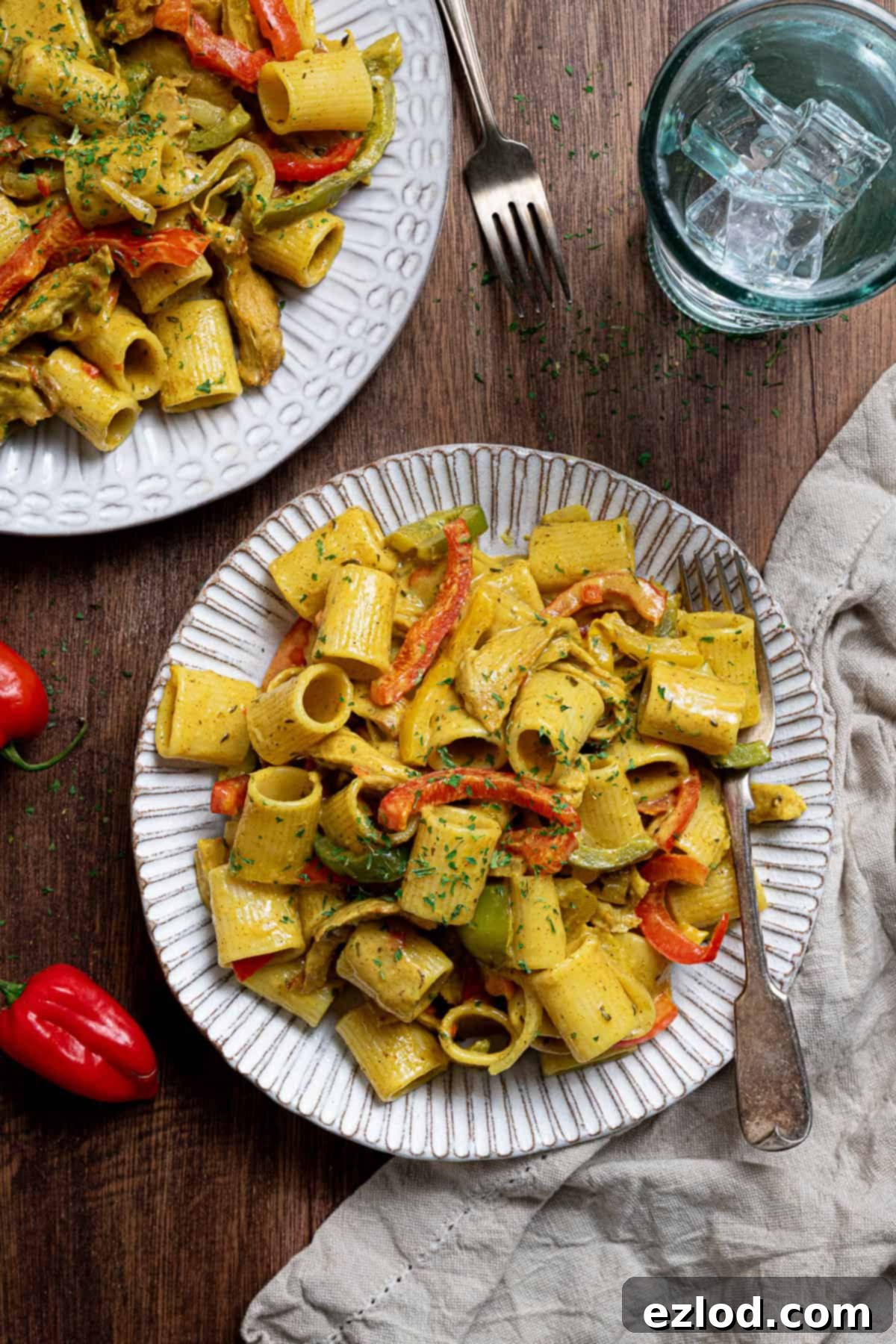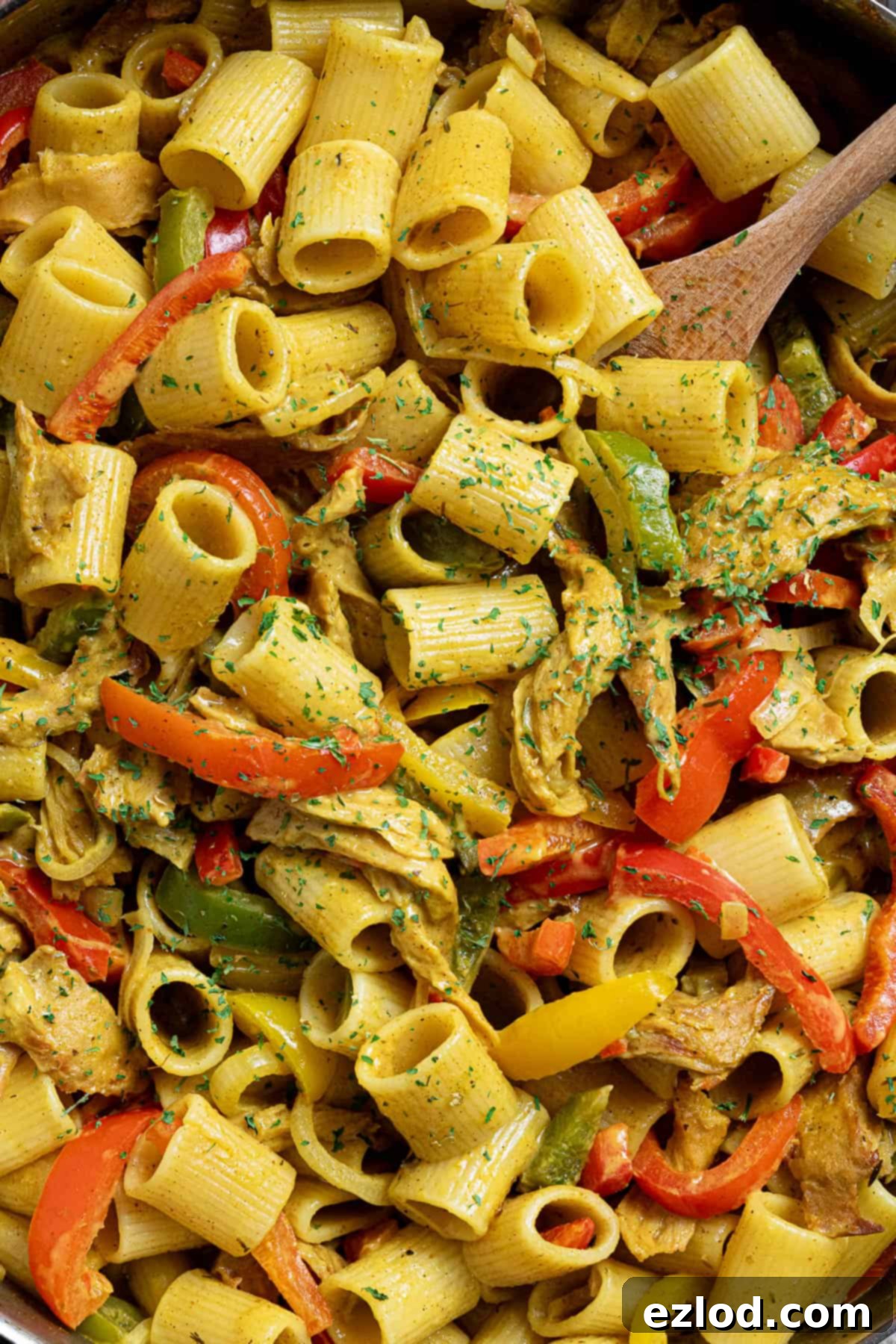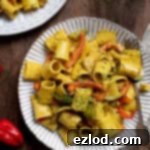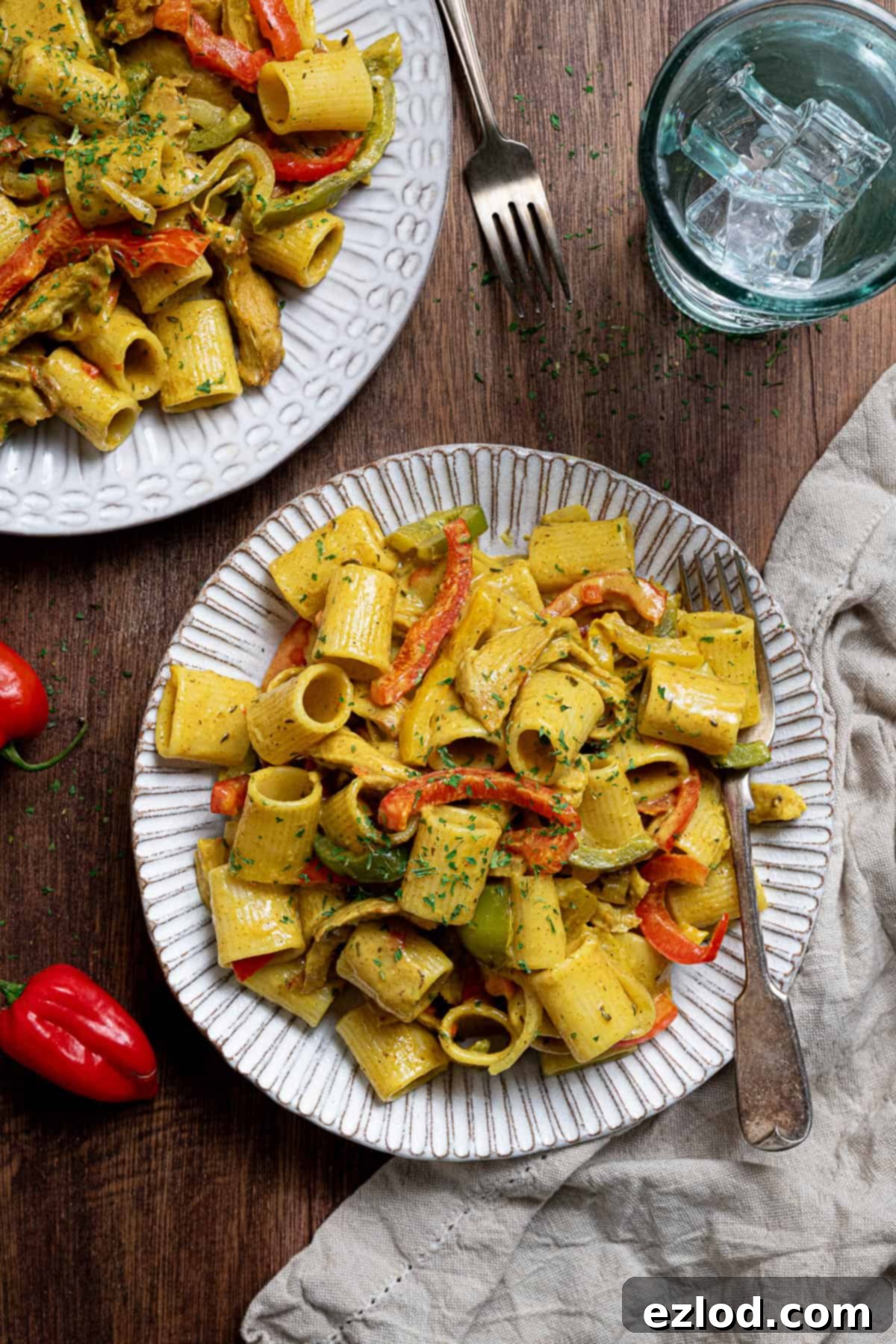Delicious & Easy Vegan Rasta Pasta: A Spicy, Creamy, and Flavorful Plant-Based Jamaican Delight
Prepare your taste buds for an unforgettable culinary journey with this incredible vegan Rasta pasta! This dish is a vibrant celebration of flavor, boasting a tantalizing blend of spicy jerk seasoning, rich coconut cream, and a medley of colorful bell peppers. Paired with tender seitan chicken and your favorite pasta, it delivers a deeply satisfying and surprisingly simple meal that’s perfect for any occasion. Whether you’re a seasoned vegan or just exploring plant-based options, this recipe promises a hearty, flavorful, and visually stunning experience that will transport you straight to the sun-drenched shores of Jamaica.

Understanding Rasta Pasta: Origins and Evolution
Rasta pasta, a culinary marvel, has a fascinating origin story deeply rooted in Jamaican culture. It was first conceived in 1985 by the talented Chef Lorraine Washington at her esteemed Paradise Yard restaurant in Negril, Jamaica. The original rendition was a simpler affair, featuring delicate fettuccine noodles generously topped with a rich red sauce and ackee, a fruit native to West Africa and a staple in Jamaican cuisine. It earned its distinctive “Rasta pasta” moniker from the construction workers frequenting the restaurant, who observed the striking red, green, and yellow hues of the dish – colors emblematic of the Rastafarian movement – and noted how the long fettuccine noodles resembled dreadlocks.
From its humble beginnings, Rasta pasta’s popularity soared, particularly in America, where it underwent a delightful transformation. The dish evolved, often incorporating a creamy, jerk-seasoned sauce, vibrant bell peppers, and protein sources like chicken or shrimp. This modern interpretation became widely loved for its bold flavors and comforting texture.
Our vegan Rasta pasta recipe takes this beloved classic and thoughtfully reimagines it for a plant-based diet without compromising on its iconic taste or satisfying creaminess. We expertly swap out traditional dairy cream and Parmesan cheese for luxurious full-fat coconut milk and savory nutritional yeast, creating a rich and cheesy sauce that is entirely dairy-free. Instead of chicken, we utilize hearty seitan, a wheat-based protein known for its excellent texture, to ensure this dish is just as filling and robust as its conventional counterpart. The result is a flavor-packed, filling, and visually stunning meal that proudly showcases the vibrant colors and dynamic flavors of Rasta pasta in a compassionate, plant-based form.

Key Ingredients for Your Vegan Rasta Pasta Masterpiece
Crafting the perfect vegan Rasta pasta starts with understanding each ingredient and its role in building that signature flavor profile. Here’s a closer look at what you’ll need:
Jerk Seasoning: The Heart of the Flavor
The cornerstone of authentic Rasta pasta is undoubtedly the jerk seasoning. For this recipe, you’ll need a dry jerk seasoning blend, not a wet marinade. Brands like Dunn’s River are excellent choices. It’s crucial to note that different brands of jerk seasoning can vary significantly in their flavor intensity, spice level, and salt content. Some blends might be quite hot, while others are milder, and their salt levels can differ wildly. Therefore, always taste your seasoning and adjust the quantity you use, along with any additional salt, to suit your preference. If your chosen blend is already very spicy, you might consider adjusting the amount of scotch bonnet pepper, or even omitting it entirely.
Coconut Milk: The Creamy Vegan Base
While traditional Rasta pasta often relies on heavy dairy cream, full-fat coconut milk is our star replacement, offering a wonderfully rich and creamy texture that perfectly emulates the original. It imparts a subtle sweetness and depth of flavor that complements the jerk seasoning beautifully. Ensure you choose full-fat coconut milk, as “lite” or reduced-fat versions will not provide the desired richness and mouthfeel. The thickness of the coconut milk is key to achieving that luscious, restaurant-quality sauce.
Bell Peppers: Color, Crunch, and Vitamins
Bell peppers are essential for both flavor and visual appeal in Rasta pasta. We recommend using an assortment of colors—red, yellow, and green—to create a truly vibrant and appetizing dish that reflects the Rastafarian flag. These peppers not only add a delightful crunch and sweetness but also provide a good source of vitamins and antioxidants. Feel free to use all of one color if that’s what you have on hand, but the mix truly makes the dish pop.
Pasta: The Foundation of the Dish
The beauty of pasta lies in its versatility. While the dish was originally created with fettuccine, a long, flat noodle that mimics dreadlocks, penne is now a common and highly practical choice as it effectively captures the creamy sauce within its tubes. However, feel free to use any pasta shape you prefer! Fusilli, rotini, or even farfalle can work wonderfully. The key is to cook your pasta slightly al dente, as it will continue to cook and absorb flavors in the sauce.
Nutritional Yeast: The Cheesy Secret
To achieve that essential savory, cheesy flavor without dairy, nutritional yeast is our secret weapon. This deactivated yeast, often fortified with B vitamins, is a staple in vegan cooking for its umami-rich, nutty profile. It works wonders as a dairy-free substitute for Parmesan cheese, adding depth and a delightful “cheesy” funk to the sauce. If you prefer, a grating of store-bought vegan Parmesan can also be used for an even more intense cheese flavor.
Seitan Chicken: Hearty Plant-Based Protein
For a satisfying protein boost, we incorporate seitan chicken shreds. Seitan, made from wheat gluten, has a remarkably similar texture to chicken and absorbs flavors beautifully. You can make your own seitan chicken shreds (as per the linked recipe) or opt for convenient store-bought vegan chicken pieces. To prepare, simply toss the seitan with a little olive oil and air fry at 180°C (350°F) for 4-5 minutes until golden and slightly crispy around the edges. Cook store-bought options according to package instructions. For those who prefer alternatives, baked, fried, or air-fried tofu, tempeh, or even roasted chickpeas make excellent substitutes.
Garlic and Ginger: Aromatic Powerhouses
Fresh garlic and ginger are crucial for building a rich, aromatic foundation for the sauce. They add a pungent, warming, and slightly spicy depth that perfectly complements the jerk seasoning. Using frozen minced garlic and grated ginger can be a fantastic time-saver without sacrificing flavor, making this recipe even easier to prepare. Fresh is always wonderful if you have it, but convenience often wins!
Scotch Bonnet Chilli: The Signature Heat and Fruity Flavor
The scotch bonnet chilli is the quintessential pepper for authentic Caribbean flavors, lending a distinctive fruity heat that truly defines Rasta pasta. For a balanced spice level, we recommend deseeding it and finely chopping it. If you crave intense heat, leave some or all of the seeds in. For a milder flavor profile with just a hint of the pepper’s unique aroma, simply throw it in whole and remove it before serving. Always handle scotch bonnets with care and wash your hands thoroughly after chopping.

Step-by-Step Guide: How To Make Vegan Rasta Pasta
(For precise measurements and complete instructions, please refer to the detailed recipe card conveniently located at the bottom of this page.)

- Step 1: Sauté Aromatics and Peppers. In a large, deep pan or Dutch oven, heat 2 tablespoons of olive oil over medium heat. Add the thinly sliced onion and a small pinch of salt, then cook gently for about 5 minutes, stirring frequently until the onion softens and becomes translucent. Next, add the vibrant sliced bell peppers, crushed garlic, grated ginger, and the finely chopped (and deseeded, if preferred) scotch bonnet chilli. Continue to cook for another 5 minutes, stirring occasionally, until the peppers begin to soften slightly but still retain a pleasant crispness.

- Step 2: Build the Flavorful Sauce. Stir in the dry jerk seasoning blend, dried thyme, and turmeric. Cook for 1-2 minutes, allowing the spices to toast and release their aromatic oils. This step intensifies their flavor. Then, pour in the full-fat coconut milk and vegetable stock, and sprinkle in the nutritional yeast. Bring the mixture to a gentle simmer and cook for approximately 2 minutes, stirring to ensure everything is well combined and the sauce starts to thicken slightly.

- Step 3: Combine and Simmer. Add the slightly undercooked pasta and the prepared seitan chicken shreds (tossed with the remaining ½ tablespoon of olive oil and air-fried until crisp). Gently stir to coat the pasta and seitan thoroughly with the creamy sauce. Continue to simmer for about 5 minutes, stirring occasionally, until the pasta finishes cooking through to al dente perfection and the sauce has thickened to your desired consistency. Taste the Rasta pasta and adjust the seasoning as needed, adding more jerk seasoning, salt, or black pepper to your preference. Serve immediately and enjoy!
Expert Tips for the Best Vegan Rasta Pasta
To ensure your vegan Rasta pasta is nothing short of spectacular, keep these handy tips in mind:
- Mastering the Spice Level: While a dry jerk spice blend is recommended, you can use a wet marinade if preferred. Start with about 1½ tablespoons of a wet marinade and adjust to taste at the end. For a milder dish, consider omitting the scotch bonnet pepper entirely, or simply add it whole to infuse flavor without too much heat, removing it before serving. For more heat, leave some seeds in the chopped scotch bonnet.
- Protein Flexibility: Don’t limit yourself to seitan chicken! Store-bought vegan chicken pieces are a convenient alternative; just cook them according to package directions before adding to the sauce. Baked, pan-fried, or air-fried tofu and tempeh are also excellent choices, offering different textures and nutritional benefits. Even sautéed mushrooms or cooked lentils can provide a delicious plant-based protein twist.
- Seasoning Savvy: Always hold off on adding significant salt until the very end of cooking. Jerk seasoning blends vary widely in salt content – some are quite salty, others contain none. Tasting and adjusting the salt and pepper at the final stage ensures your dish is perfectly seasoned to your liking.
- Garnish for Freshness: A fresh garnish elevates the dish significantly. Finely chopped fresh coriander (cilantro), parsley, or sliced spring onions (scallions) add a burst of freshness and vibrant color. A squeeze of fresh lime juice just before serving can also brighten the flavors beautifully.
- Al Dente Pasta is Key: Ensure you cook your pasta slightly undercooked (al dente) before adding it to the sauce. It will finish cooking in the creamy sauce, absorbing all the wonderful flavors and preventing it from becoming mushy.
- Meal Prep Potential: This vegan Rasta pasta makes excellent leftovers! Prepare a larger batch for meal prepping throughout the week. Store it in an airtight container in the fridge, and it will keep well for up to 3 days.
- Serving Suggestions: While a complete meal on its own, this Rasta pasta pairs wonderfully with a simple green salad, some fluffy coconut rice, or even a side of fried plantains for an extra authentic Caribbean touch.
Frequently Asked Questions About Vegan Rasta Pasta
Any leftover vegan Rasta pasta should be transferred to an airtight container and stored in the refrigerator for up to 3 days. To reheat, gently warm it in a pan on the stovetop over medium-low heat. You may find the sauce has thickened considerably in the fridge, so add a splash of vegetable stock or a little more coconut milk as needed to loosen it back to your desired consistency.
Absolutely! To make this vegan Rasta pasta gluten-free, simply choose a high-quality gluten-free pasta. Additionally, always double-check the labels of your vegetable stock and jerk seasoning blend to ensure they are certified gluten-free, as some brands may contain hidden gluten ingredients. For the protein, substitute the seitan chicken with baked or pan-fried tofu, tempeh, or even roasted chickpeas, as seitan is wheat-based and therefore contains gluten.
The spice level of this vegan Rasta pasta can be easily customized to your preference, but as written, it is generally considered mildly spicy rather than intensely hot. The heat largely depends on the specific brand of jerk seasoning you use and how you handle the scotch bonnet chilli. If you love a fiery kick, opt for a jerk seasoning with chilli high up on its ingredient list, and be sure to leave the seeds in the scotch bonnet when you chop it. For a more subtle heat, choose a jerk seasoning where chilli is listed lower down, and either omit the scotch bonnet entirely or add it whole (and remove before serving) to capture its fruity aroma without the intense heat.
Certainly! This recipe is quite versatile. Feel free to incorporate other vegetables that you enjoy. Spinach or kale can be wilted into the sauce at the end for added greens. Sautéed mushrooms, zucchini, or even roasted sweet potato cubes could also make delicious additions, enhancing both the flavor and nutritional profile of your Rasta pasta.

Discover More Delicious Vegan Pasta Dishes:
If you loved this vegan Rasta pasta, we invite you to explore more of our delightful plant-based pasta recipes. From comforting classics to innovative creations, there’s a pasta dish for every craving!
- Scissor Cut Tofu Pasta With Creamy Gochujang Sauce (vegan)
- Vegan Lentil Walnut Bolognese
- Creamy Vegan Mushroom Pasta With Truffle Oil
- Sun Dried Tomato Puy Lentil Pasta (Vegan)
- Vegan Spinach And Ricotta Stuffed Pasta Shells
Stay connected with us for daily inspiration and the latest recipes! Follow us on Instagram, Pinterest, and Facebook. Don’t miss a single recipe – subscribe via email to get all our newest culinary adventures delivered straight to your inbox!
All images and content featured on Domestic Gothess are protected by copyright. If you wish to share this recipe, please do so by utilizing the provided share buttons. We kindly request that you do not screenshot, repost the full recipe, or reproduce our content in its entirety. Instead, please include a direct link back to this post for the recipe. Thank you for respecting our work!

Vegan Rasta Pasta
Ingredients
- 400 g (14 oz) uncooked dry pasta
- 300 g (10 ½ oz) seitan chicken shreds*
- 2 ½ Tablespoons olive oil divided
- 1 large onion peeled and thinly sliced
- 4 bell peppers (use an array of colours) sliced into strips
- 4 cloves garlic peeled and crushed
- 1 Tablespoon grated fresh ginger
- 1 scotch bonnet chilli** deseeded and finely chopped
- 2 Tablespoons dry jerk seasoning blend*** (more to taste)
- 1 teaspoon dried thyme (or 4 sprigs fresh)
- ½ teaspoon turmeric
- 1 400 ml (14 oz) tin full fat coconut milk
- 250 ml (1 cup) vegetable stock
- 4 Tablespoons nutritional yeast
- salt and pepper
Instructions
-
Cook the pasta in a large pan of generously salted water for a couple of minutes less than the directions on the packet state. The goal is for it to be very slightly undercooked, or ‘al dente’, as it will finish cooking in the sauce. Drain thoroughly and set aside.400 g (14 oz) uncooked dry pasta
-
While the pasta cooks, prepare your seitan chicken. Toss the seitan shreds with ½ Tablespoon of olive oil until lightly coated. Air fry at 180℃/350℉ for 4-5 minutes, or until the seitan is heated through and starts to develop a slight crispness around the edges. Set aside.300 g (10 ½ oz) seitan chicken shreds*
-
Meanwhile, heat the remaining 2 Tablespoons of olive oil in a large, deep pan or Dutch oven over medium heat. Add the thinly sliced onion along with a small pinch of salt. Sauté, stirring often, for about five minutes, or until the onion has softened and turned translucent.2 ½ Tablespoons olive oil, 1 large onion
-
Add the vibrant sliced bell peppers, crushed garlic, grated fresh ginger, and the finely chopped scotch bonnet chilli (deseeded if you prefer less heat). Continue to cook for approximately another 5 minutes, stirring occasionally, until the peppers have softened slightly but still retain some texture.4 bell peppers (use an array of colours), 4 cloves garlic, 1 Tablespoon grated fresh ginger, 1 scotch bonnet chilli**
-
Stir in the jerk seasoning blend, dried thyme (or fresh sprigs), and turmeric. Cook for an additional minute or two, stirring constantly, to allow the spices to bloom and release their full aroma.2 Tablespoons dry jerk seasoning blend***, 1 teaspoon dried thyme (or 4 sprigs fresh), ½ teaspoon turmeric
-
Pour in the full-fat coconut milk, vegetable stock, and nutritional yeast. Stir well to combine all ingredients. Bring the mixture to a gentle simmer and let it cook for about 2 minutes, allowing the sauce to slightly thicken.1 400 ml (14 oz) tin full fat coconut milk, 250 ml (1 cup) vegetable stock, 4 Tablespoons nutritional yeast
-
Add the pre-cooked pasta and the air-fried seitan chicken to the pan. Stir everything together thoroughly, ensuring the pasta and seitan are fully coated in the creamy sauce. Continue to simmer for about 5 minutes, stirring often, until the pasta has finished cooking through to your desired texture and the sauce has thickened to a luscious consistency.
-
Taste the Rasta pasta and adjust the seasoning as required. You may wish to add an additional ½ Tablespoon of jerk seasoning to enhance the flavor. Taste again and season generously with salt and freshly ground black pepper to your preference. Serve hot and savor this incredible vegan delight!salt and pepper
Notes
- *If you prefer not to use seitan chicken, you can easily substitute with store-bought vegan chicken pieces. Ensure you cook them according to the package instructions before adding them to the sauce. Other excellent alternatives include baked, fried, or air-fried tofu, or tempeh, which all absorb flavors wonderfully.
- **For those who prefer a milder dish, you can either completely omit the scotch bonnet chilli or simply throw it in whole during cooking and remove it before serving. This method allows you to infuse some of its distinctive fruity flavor into the sauce without adding excessive heat.
- ***This recipe specifically uses a dry jerk spice blend for ease and flavor profile. If you only have a wet jerk marinade, you may need to adjust the quantity and potentially reduce other liquid ingredients slightly. Start with 1½ tablespoons of wet marinade and adjust to taste.
We’d love to hear about your culinary creations! If you tried this recipe, please let us know how it turned out. Rate it, leave a comment below, or share your delicious results on Instagram by tagging @domestic_gothess and using the hashtag #domesticgothess. Your feedback and photos brighten our day!
